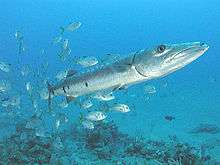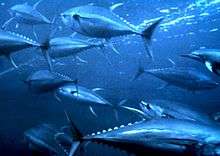Data storage tag
A data storage tag (DST), also sometimes known as an archival tag, is a data logger that uses sensors to record data at predetermined intervals. Data storage tags usually have a large memory size and a long lifetime. Most archival tags are supported by batteries that allow the tag to record positions for several years. Alternatively some tags are solar powered and allow the scientist to set their own interval; this then allows data to be recorded for significantly longer than battery-only powered tags.
Operation
Data storage tags can have a variety of sensors; temperature, depth, light, salinity, pressure, pitch and roll, GPS, magnetic and compass.[1] They can be used internally or externally in fish, marine animals[2] or research animals. They are also used in other industries such as the food and beverage industry.[3]
At the end of the monitoring period, the loggers can be connected to a computer and the data uploaded for analysis. Data collected by data storage tags can be used to infer locations of the animal when it is at large.[4] [5] [6]
Deployment
Archival tags archive data to internal memory. Once they are recovered the data is then extracted by the researcher. The tag is generally mounted to the animal either by cutting a slit into the animal, inserting the tag, and sewing the opening closed. Alternatively researchers externally attach tags to animals by running anchor lines through the tag and into the dorsal fin for most "fish" species. For turtles the tag is epoxied to the shell of the turtle. [7]

See also
Notes
- ↑ "FISHBIO Fish Marking". fishmarking.com.
- ↑ http://www.star-oddi.com/resources/Files/pdf/113_Tagging-the-starfish.pdf
- ↑ "Fish tags & animal tags for oceanographic and freshwater research - Star-Oddi". star-oddi.com.
- ↑ Metcalfe, J. D.; Arnold, G. P. (1997-06-12). "Tracking fish with electronic tags". Nature. 387 (6634): 665–666. doi:10.1038/42622. ISSN 0028-0836. Retrieved 2015-09-17.
- ↑ Pedersen, M. W.; Righton, D.; Thygesen, U. H.; Andersen, K. H.; Madsen, H. (2008). "Geolocation of North Sea cod (Gadus morhua) using hidden Markov models and behavioural switching". Canadian Journal of Fisheries and Aquatic Sciences. 65 (11): 2367–2377. doi:10.1139/f08-144.
- ↑ Righton, David; Mills, CraigM. (2008). "Reconstructing the movements of free-ranging demersal fish in the North Sea: a data-matching and simulation method". Marine Biology. 153 (4): 507–521. doi:10.1007/s00227-007-0818-6. ISSN 0025-3162.
- ↑ "TAG ATTACHMENT METHODS". hafro.is.

